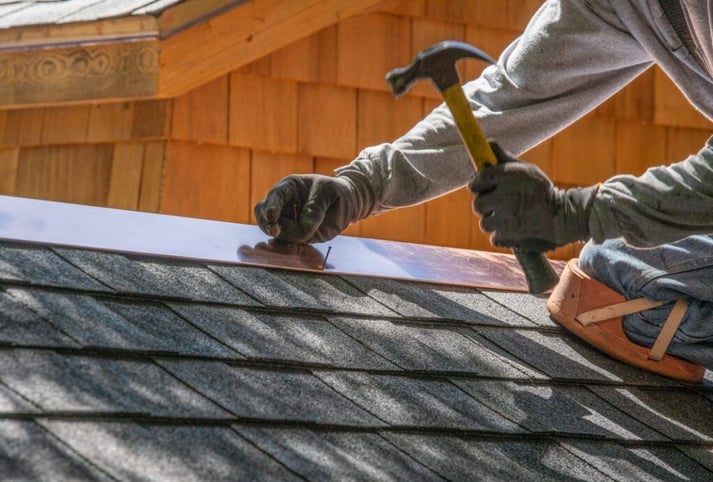
Roof leaks can be a homeowner’s nightmare, causing significant damage to the structure and interiors of your home if left unaddressed. Learning how to repair a roof leak is crucial in maintaining the integrity of your home and avoiding costly repairs in the future. This guide will walk you through the steps involved in diagnosing and learning how to repair a roof leak, ensuring your home remains dry and secure.
Understanding the Cause And How To Repair a Roof Leak
Before you can tackle a repair, it’s important to understand what causes roof leaks. Common causes include:
- Broken or Missing Shingles: Harsh weather conditions and physical damage can lead to broken or missing shingles, which expose the underlayment or roof deck to water.
- Improperly Sealed Valleys: The valleys, where two roof planes come together, if not properly sealed, can allow water to seep through and cause leaks.
- Cracked Flashing: Flashing are thin pieces of metal installed at transitions on your roof to prevent water from seeping in. Over time, the tar used to seal the flashing can corrode, causing cracks.
- Clogged Gutters: When gutters are clogged, water can back up and seep into the eaves, leading to leaks.
- Cracked Vent Booting: Vent booting seals areas around roof vents against moisture. Cracks or breaks in vent booting can allow water into your home.
- Ice Dam Buildup: In colder climates, ice dams can form at the edge of your roof and prevent snow from draining off, forcing water under your shingles.
Detecting Roof Leaks
Before you learn how to repair a roof leak learn how to detect a roof leak early which can be the key to preventing extensive damage. Here’s how you can identify a roof leak:
- Water Stains on the Ceiling: One of the most obvious signs of a roof leak is water stains or dampness on the ceiling.
- Dripping Water: If you see dripping water during or after a rainstorm, it’s a clear sign of a roof leak.
- Missing or Damaged Shingles: Visually inspect your roof for missing shingles, cracks, or wear, especially after severe weather conditions.
- Moss or Algae Growth: Excessive moss or algae growth on your roof can be a sign of trapped moisture, indicating potential leaks.
Tools and Materials Needed
To repair a roof leak, you’ll need the following tools and materials:
- Ladder
- Hammer
- Pry Bar
- Roofing Nails
- Roofing Sealant
- Replacement Shingles
- Flashing
- Utility Knife
Step-by-Step Guide on How To Repair a Roof Leak

Step 1: Locate the Leak From inside your attic, look for water stains, mold, or black marks. If you can’t access your attic, inspect the roof for signs of damage above the location where the leak is occurring.
Step 2: Replace Damaged Shingles If you discover damaged shingles:
- Use a pry bar to remove the nails holding the damaged shingle.
- Slide out the old shingle and replace it with a new one.
- Secure the new shingle with roofing nails.
- Apply roofing sealant over the nails to waterproof them.
Step 3: Repair Flashing If the flashing is the problem:
- Remove any shingles around the damaged flashing to expose it.
- Pry up the existing flashing and remove it.
- Cut and shape new flashing to fit and secure it with roofing nails.
- Re-cover the area with new shingles as described above.
Step 4: Seal the Valleys If leaks are coming from the valleys:
- Clear the valley of any debris.
- Apply a thick bead of roofing sealant along the seam of the valley.
- Press down the edges of the adjoining shingles into the sealant.
Step 5: Unclog Gutters Ensure your gutters are clean to prevent water backup. Remove debris and flush the gutters with water to check for proper drainage.
Preventive Measures So You Don’t Have to Learn How To Repair a Roof Leak
- Regular Inspections: Conduct bi-annual inspections of your roof to catch potential issues early.
- Trim Overhanging Branches: Reduce roof damage by trimming branches that could scrape or puncture roof shingles.
- Improve Ventilation: Good attic ventilation can prevent moisture buildup that leads to roof rot.
The Importance of Trimmed Trees

Conclusion
Knowing how to repair a roof leak is an essential skill for any homeowner in Fayetteville. Regular maintenance, timely repairs, and a comprehensive understanding of the causes of roof leaks can significantly reduce the hassle and expenses associated with water damage. Staying proactive about checking for signs of wear and damage, especially after severe weather events, can prevent small issues from escalating into major problems.
Implementing routine inspections and addressing minor leaks immediately can extend the life of your roof and ensure it continues to protect your home effectively. This kind of vigilance helps maintain the overall structural integrity of your home, preventing moisture from compromising insulation, electrical systems, and internal structures.
However, it is important to recognize when a repair job is beyond your capabilities. If a roof leak is severe or the damage appears extensive, it is crucial to contact a professional roofing contractor like Pinnacle Roofing. These experts have the tools, knowledge, and experience to carry out repairs safely and effectively. They can also perform a thorough assessment to identify any potential future risks, ensuring all underlying issues are addressed. Hiring professionals not only guarantees a high-quality repair but also ensures that all aspects of the job comply with local Fayetteville building codes and safety standards. This approach not only protects your home but also safeguards your investment in the long run.






